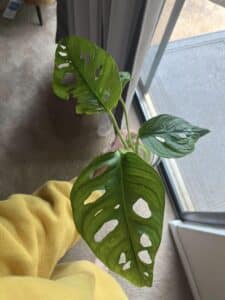As Monstera matures, it makes new leaf, every couple of weeks to boast lobed-infused foliage.
But if your Monstera is not putting out more leaves, read on to learn tips to grow more of them.
Table of Contents Show
Why is My Monstera Not Putting Out New Leaves?
The drastic imbalance in fundamental care factors can halt Monstera’s growth.
1. Improper Sunlight
To maintain their monstrous stature, Monstera plants need at least 6 to 8 hours of daily bright indirect sunlight.
Monstera placed in a dark, shady place may not receive optimal light resulting in no new leaf growths.
Remember, sunlight directly impacts the energy flow in the plant due to photosynthesis.

Therefore, light deprivation could be the main culprit behind disabling your Monstera to put on new leaves.
On the contrary, excess exposure to direct sunlight can sunburn the delicate leaves of Monstera.
Tips to Provide Optimal Lighting
- Place your Monstera plants in the east or south-facing window with sheer curtains.
- Monsteras do not complain about the light source, so give them at least 10 hours of growth light.
- Keep the plant at least 3 to 5 feet away from the window to avoid direct sunburn.
- Give your Monsteras incandescent grow lights during winter to keep them warm while giving proper light.
2. Improper Watering
Monstera prefers watering every 1 to 2 weeks and does not prefer wet feet.
Let the top few inches of the soil to be dry between waterings.
Underwatered Monstera often produces droopy, wrinkling, crispy leaves, suppressing plant growth.
In contrast, overwatering causes Monstera plants to develop brown spots on yellowing leaves.
Proper Watering Tips for Monstera
- Invest in a moisture meter to detect the moisture content in the soil to water accordingly.
- Ensure the plant pot has multiple drain holes to facilitate a way out for excess water.
- Avoid overhead watering; avoid the leaves from getting wet, or opt for a bottom-watering approach.
- Water your Monstera with rainwater or filtered water, and before using tap water, let it sit for a night.
3. Low Humidity
Generally, Monstera plants do well at 40% relative indoor humidity level.
However, Monstera needs significantly higher humidity than its natural habitat to grow its new leaves.

For the vigorous growth of the Monstera, the suggested humidity level is at 80%, which is identical to its ideal home.
Tips to Maintain Higher Humidity
- Invest in a good quality humidifier and mist your plants daily in the morning.
- Mist your plants daily in the morning to keep them humid throughout the day but do not overdo it.
- Place the pebble tray underneath the Monstera plant pot, partially filled with water.
- Relocate your Monsteras in relatively higher humid rooms like spacious kitchens and bathrooms.
High humidity for a long period can invite various pests and fungal diseases that can harm the plant resulting in no new growths.
4. Nutrient Deficiency
Macronutrients like Nitrogen in the soil directly influence the foliage growth of the plant.
Generally, Monstera prefers fertilization once a month with diluted nitrous fertilizer.
When the Monstera plant lacks nutrients, the plant’s growth drastically stops along with the chlorosis of the plant leaves.
Tips to Fertilize Monstera Properly
- Increase fertilization during spring and summer as they are the active seasons.
- Reduce fertilization in winter, which can cause root burn and ultimately restrict growth.
- Fertilize your Monstera only after watering them and letting them stay moist overnight.
- Always dilute the liquid fertilizers to half their strength and pour them directly on the plant soil.
- Opt for organic fertilizers like compost and worm castings.
5. Rootbound Condition
Monstera plants kept indoors can reach the monstrous size of almost 10 to 15 feet tall when provided with ideal care.
But when their roots are bounded, they cannot provide enough nutrients to the plant to achieve such feats.
Therefore, if your Monstera plant is not unfurling any new leaves, it could be because of rootbound conditions.

In general, it is recommended to repot your Monstera plants on an annual basis to ensure enough room for roots.
Here I have included a few signs your Monstera may show when they need repotting.
- Your Monstera plant has outgrown the pot.
- Roots are peeking out from the drain holes.
- Water quickly drains out from the pot.
- Monstera has been showing stunted growth.
Consider repotting your Monstera during the early spring before the active growth kicks in, and use a proper potting mix that facilitates well-drainage.
6. Monstera Variety Differences
The variegation in Monstera plants is something eyes love to behold, but they take a long time to get big.
Meanwhile, non-variegated Monstera plants grow much faster, adding new leaf growth every few weeks.

Due to the lack of chlorophyll in the variegated leaves, they cannot prepare food, affecting the growth rate.
For example, Swiss Cheese Monstera can add almost 60 to 70 leaves per year, whereas Monstera Obliqua hardly makes 3 or 4 new leaves.
Nonetheless, give them proper care and attention, and let them take time to unfurl their leaves.
How Often Does a Monstera Produce a New Leaf?
Interestingly, Monstera seems to welcome new leaves more frequently as they mature.
Similarly, mature Monstera has more nodes available, making more room for new Monstera leaves.
Monstera leaves appear in different growth stages. Firstly, Monstera produces small abortive leaves in their juvenile stage called cataphylls.
And when they get mature, they produce large, heart-shaped variegated leaves.
That said, the growth of the Monstera plant may vary depending on where they are located.
Besides the positioning of the Monstera, seasons also influence the frequency of Monstera producing new leaves.
Monstera plants undergo active growth during the Spring and Summer time of the year.

But they are dormant in winter, barely adding new leaves in colder months.
Once the Monstera plant adds a new leaf from one of its nodes, it takes almost 1 to 2 weeks to uncurl them.
Therefore, you must always give Monstera the best care possible to add new leaves vigorously.
Here is the Monstera new leaf time-lapse video!
Tips to Stimulate Monstera to Grow New Leaves
Now that you know the potential of your Monstera, here are some strategies to make Monstera grow more leaves.
- Carefully prune old, dying, or damaged leaves or part of the Monstera before the active growing season starts to encourage new leaf growth.
- Ensure to clean the Monstera leaves to keep them dust-free and safe from pests and fungal diseases.
- Maintain the temperature range between 65 to 85℉ for optimum growth.
- Give your plants a slow-releasing fertilizer before the active growth season, followed by proper watering.
- Regularly check your plant for pests and illnesses. Use insecticidal soap and neem oil regularly to avoid pest and disease infections.
- Offer your Monstera a structure to climb on, so they can get much bushier quickly.
From Editorial Team
Conclusion!
Your Monstera will bless you with a beautiful, brand-new leaf every month if you provide a dream home.
Let there be adequate lighting, proper watering, and high humidity, and your Monstera will keep adding new leaves with no complaint.
